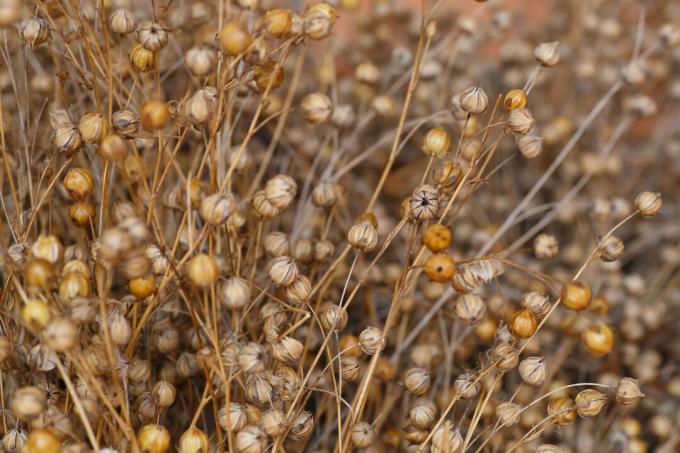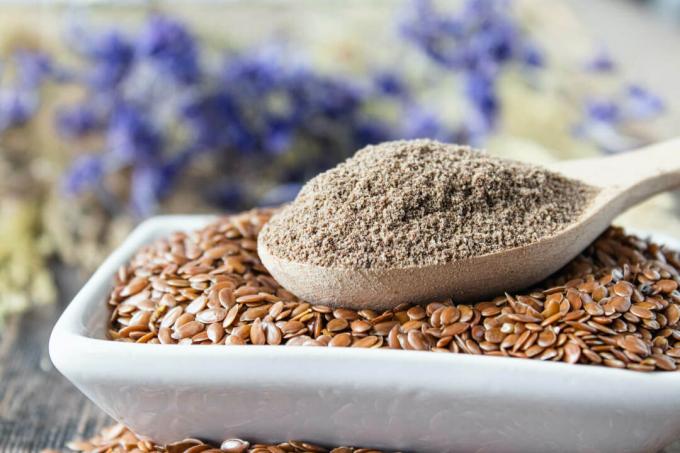Linseed is considered a regional and healthy superfood. With us you will learn everything about the harvest, storage and effects of flaxseed on digestion.

Flaxseeds are the seeds of common flax (Linum usitatissimum), which can also be grown in the garden. Because of its numerous beneficial properties, flaxseed should be part of any healthy diet. We give tips on harvesting flaxseed, optimal storage and what to consider when buying and using flaxseed.
contents
- Harvesting and storing flaxseed
- use of flaxseed
-
How should you eat flaxseed?
- Can you eat flaxseed raw?
- Should you eat flaxseed ground or whole?
- Do you have to soak flaxseed?
- effect of flaxseed
- Are Flax Seeds Healthy?
Harvesting and storing flaxseed
The seeds of the flax ripen in midsummer from the end of July to mid-August, when the plants die and turn brown. The most important sign that the linseed is dry enough and therefore ready for harvest is the rustling of the grains in the capsules. When harvesting, the entire plant is cut off and placed in a burlap sack or bag to thresh out the seeds. Using a stone rolling pin, the capsules can be easily cracked open without damaging the flax seeds. Alternatively, free the seeds by walking over them with your feet. The harvested flaxseed should be cleaned by sieving or airflow to remove capsule remains and other plant parts. Fresh linseed can be pressed directly into oil. To store the flax seeds, they should first dry at room temperature for a few days. The seeds find ideal conditions in a cool, dry and dark environment, for example filled in mason jars. Linseed can be stored for about two years without hesitation.
tip: Freshly pressed linseed oil can only be stored in the refrigerator for about two months, as it quickly goes rancid.

use of flaxseed
Flaxseed can be enjoyed pure or in the form of flaxseed oil. Their oil is high in omega-3 fatty acids and should therefore not be heated. The nutty-tasting, golden-yellow linseed oil is ideal for the preparation of salads, cold appetizers, spreads and pesto.
Oil paints and glazes can also be made very well from linseed oil.
The press cake from oil extraction can be used as animal feed.
The pure seeds, on the other hand, are traditionally found in muesli, bars and baked goods. Linseed sprouts can be grown on any windowsill from untreated seeds and harvested after just three days. In vegan cuisine, the gelatinous mass of the swollen flaxseed is used as an egg substitute or as an alternative to pudding.
Use flaxseed or chia seeds and psyllium? Chia seeds (Salvia hispanica), linseed and psyllium (plantago) all have a positive effect on digestion. They have a high fiber content, a high swelling capacity and are considered to be superfood. However, flaxseed can be produced regionally in domestic cultivation, while chia seeds and psyllium seeds have so far been are mainly grown in South America and India and therefore have a large ecological footprint cause.

How should you eat flaxseed?
Flaxseed can be added to many dishes and consumed daily. The daily dose is between one and two tablespoons, with a short-term intestinal cure for a few days up to 45 g per day can be taken. It is important to always drink enough water with the swelling flaxseed.
Can you eat flaxseed raw?
Flax seeds can be eaten raw without any problems. Heating when baking, roasting or roasting even has a negative effect on their healthy ingredients. Linseed oil is therefore cold-pressed and should only be used cool.
Should you eat flaxseed ground or whole?
Flaxseed in crushed or ground form offers a much better surface for stomach acid to attack than the whole seed, which is often excreted whole if not chewed. On the other hand, minerals, protein and fatty acids can be absorbed more easily from seeds that have already been crushed. Ideally, you always make the flaxseed meal fresh yourself, because important ingredients are lost over time during storage. Ground flaxseed or grist can therefore only be kept for about six months without loss or changes in taste. However, the swelling effect persists whether the flaxseed is crushed, ground, or eaten whole.

Do you have to soak flaxseed?
Flaxseeds do not have to be soaked in principle, as they bind water anyway on their way through the digestive tract and also develop their swelling effect. However, soaking flaxseed beforehand can be useful if you have digestive problems. The so-called flaxseed tea is said to work particularly well for constipation, irritable bowel syndrome, gastric mucosal irritation and heartburn. Here, two teaspoons of, at best, freshly ground flaxseed are allowed to swell in 200 ml of cold water for about 30 minutes and then the liquid is filtered through a fine sieve. The digestive substances are released from the seeds and drunk pure.

effect of flaxseed
Thanks to their mucilage, flaxseed can swell up with water and thus increase the volume of the food. This promotes intestinal activity in the intestine, which is why linseed is used to treat constipation. They are most effective around 12-24 hours after ingestion. Consumed in excess or if too little has been drunk, the effect of flaxseed is reversed and can lead to constipation or even intestinal obstruction. The maximum daily dose of flaxseed should therefore not be exceeded and care should always be taken to ensure adequate fluid intake. Linseed oil has a similar laxative effect without binding water and is also available as a capsule.
Linseed for Horses: When keeping horses, flaxseed can be added to the feed for digestive problems and light colic. Ideally, ground flaxseed should be allowed to swell before being fed to horses so that the active substances can be absorbed well.
Flaxseed for Dogs: Dogs also benefit from linseed, because the four-legged friends quickly suffer from digestive problems. Here, too, you should ensure that you have sufficient fluid intake when feeding and administer the flaxseed with water. The healthy ingredients also lead to shiny fur or hair in humans and animals.

Are Flax Seeds Healthy?
Flaxseeds are healthy and low-carb seeds. They consist of about 25% indigestible fiber, 25% protein and 30-45% oil, with unsaturated omega-3 fatty acids being particularly high. In addition, minerals such as iron and vitamins E and K are present in flaxseed. Flaxseed sprouts can be similar to cress (Lepidium sativum) grow on the windowsill all year round and thus provide nutrients and vitamins even in the cold season. However, flaxseeds are considered calcium robbers, which is why the seeds are always best combined with calcium-containing foods such as dairy products or cabbages (Brassicaceae) like Kale (Brassica oleracea var. sabellica) or broccoli (Brassica oleracea var. italiana) are consumed. Traditionally, the nutty linseed oil is stirred into quark as a dip for boiled potatoes.
Another oil crop that can be grown and harvested in your own backyard is the oil radish (Raphanus sativus var. oleiformis). We introduce the cabbage plant (Brassicaceae) and give tips on how to successfully cultivate the green manure plant.



